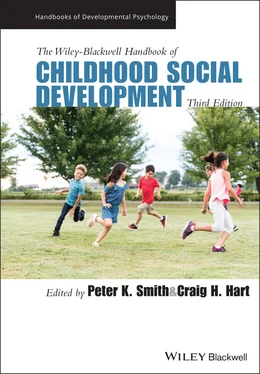Finally, there is emphasis on time in development. For example, the stability of development, and experiences of continuity and change in the individual and their environment are of interest. So too are notions of intensity, in relation to the frequency and duration of interactions in the short term (minutes, days) and long term (across the lifespan). Timing is also significant for both when in someone’s life trajectory an event or experience occurs, but also the point in history that people are living through and the sociocultural shifts and changes that occur over time.
How Ecological Perspectives can be used to Understand Social Development
A child’s social development forms the basis for how they come to understand the social world, how they form and maintain relationships with others, and how they make moral decisions. These all require sophisticated skills and rely on individuals being able to judge what is appropriate in situations based on complex social judgments and in response to subtle social cues. How children navigate this is shaped by their previous experiences of relationships and the interactions they have with others. They will see how others behave and react towards them and others – contributing towards their own self‐perception. They will also be influenced by cultural values, which set out expected norms surrounding emotional expression, social actions, and decisions about moral conduct. Children’s social development therefore needs to be considered in view of their social and cultural experiences.
The benefit of ecological perspectives here is their attention to the multitude of intersecting factors that contribute to social development, and their recognition of the multilayered spheres of influence – from those that are direct and immediate, to those that are more remote and subtle. Ecological perspectives emphasize relationships and reciprocity. The person is not a lone individual – they are part of a complex system of networked interactions. Ecological perspectives are therefore, by their nature, social and can offer a valuable lens for understanding various domains of social development.
It would not be feasible in this chapter to explore multiple aspects of social development. Therefore, the intention is to examine two focused examples (namely, parenting and attachment, and bullying) and explore in more detail the contribution of ecological perspectives to our understanding of these specific areas.
Attachment is the strong affectional bond established between a child and their caregiver ( Chapter 23, this volume). Bowlby (1969) claimed that infants have a biological predisposition to form attachments, which is expressed through sucking, clinging, smiling, vocalizing, and crying. Adults respond to these signals, the child then responds to the adult, and relationships are formed through this ongoing mutual exchange. Adult sensitivity to the child’s behaviors, and attunement to their physical and emotional needs is the basis of effective parenting and establishes attachment. Secure attachment provides children with warmth, intimacy, and stability, and creates the optimal conditions for ongoing development. In contrast, unresponsive, neglectful, or inconsistent caregiving can result in insecure attachment. Although not inevitable, insecure patterns of attachment can be a risk factor for poorer developmental outcomes (Sroufe, 2005).
From an ecological perspective, the primary attachment relationship is the first context for children’s development (Harney, 2007), and the reciprocal interactions between parent and child form the microsystem. Through these everyday interactions, they form an internal representation about themselves and others. This cognitive representation, known as the internal working model, provides the template for future interactions and affects expectations of other relationships (Bowlby, 1969). Children expecting warm responsive behavior in others will likely approach new social encounters with openness and positivity. Those expecting rejection will approach others with caution and hostility. In turn, these actions will provoke certain responses in others, which can initiate a chain of events with differential consequences (Bronfenbrenner & Morris, 2006).
One implication is that a person’s internal working model impacts on the parenting practices they subsequently adopt with their own children. An ecological perspective considers individual and contextual factors that contribute to the continuity or discontinuity of intergenerational transmission, including moderators such as parent’s later attachment relationships, social context, and characteristics of the child (Sette et al., 2015). While parents’ own attachment representations may be used to interpret and respond to their child’s cues, they will also adapt and finely tune their actions in response to the immediate caregiving experience. Characteristics of the child (such as their temperament, personality), amount of parental support available, and how the parent perceives themselves all contribute (Solomon & George, 1996). Parenting is a practice, and the way individuals approach this role is dependent on their personal characteristics, their own attachment experiences, and the context they are in (River et al., 2019; Vaughn et al., 1979; Yoo, 2019).
This shows the influence of ecological factors on parenting and highlights the need to consider other systems that are immediate and more distant to the parent–child relationship (Lickenbrock & Braungart‐Rieker, 2015). For example, at the macro level, there is cultural variation in the desirability of certain attachment behaviors, diversity in norms surrounding the expression of emotion, between‐country differences in child‐rearing practices, and international variations in governmental policies around childcare and parental leave – all of which impact on parenting at the local level (Bornstein et al., 2008; Köster et al., 2016; Sette et al., 2015; Weisner, 2005).
At the chronological level, social norms about “when” it is acceptable to become a parent mean that the experience of parenting may be different depending on when in someone’s life this occurs. For example, there are prevailing societal narratives in Western contexts that position teenage parents negatively and stereotype them as “at risk” or vulnerable to dysfunctional outcomes (Chase, 2019). Whilst there have been historical changes in the manifestations of this, negative portrayals remain and can shape the way young mothers present themselves (Jones et al., 2019).
There are also historical changes in the way that childhood and parenting is conceptualized, with changing family structures, increased diversity in parental roles, and a tendency towards more democratic approaches to contemporary parenting (Gabriel, 2017; Volling, 2020). Additionally, at a societal level, the widespread increase in technology has changed the demands on parents raising children in the digital age (Livingstone & Ross, 2020), and the strategies adopted to regulate children’s technology use have been shown to vary depending on child characteristics and parents’ digital literacy (Benedetto & Ingrassia, 2020) – adding further support to ecological positions. Theoretical positions and scholarly frames of reference need to expand to reflect society as it evolves, therefore our understandings of attachment and children’s social development need to be considered within shifting social constructions of parenting and childhood (Gabriel, 2017). In this vein, the emphasis that ecological perspectives place on change and chronology can be helpful in ensuring the currency of ideas around attachment and parenting to modern life.
There is the risk of Western egocentrism in theories about attachment and parenting because despite attachment theory recognizing the role of context and culture (Thompson, 2021), there is a more established empirical research base conducted in Western compared to non‐Western contexts. There is a need for more contextually sensitive research which adds insight into the cultural meaning and interpretations of certain parenting practices (Thompson, 2021). This is where the application of ecological perspectives could be particularly valuable. They force us to examine intersecting factors and avoid applying overly simplified cause–effect models of development that ignore variability and complexity. They also cause us to reflect on the questions posed by research, and the methodological tools used in empirical investigations to ensure they adequately account for context, process, and time. These points will be revisited later in the chapter.
Читать дальше












